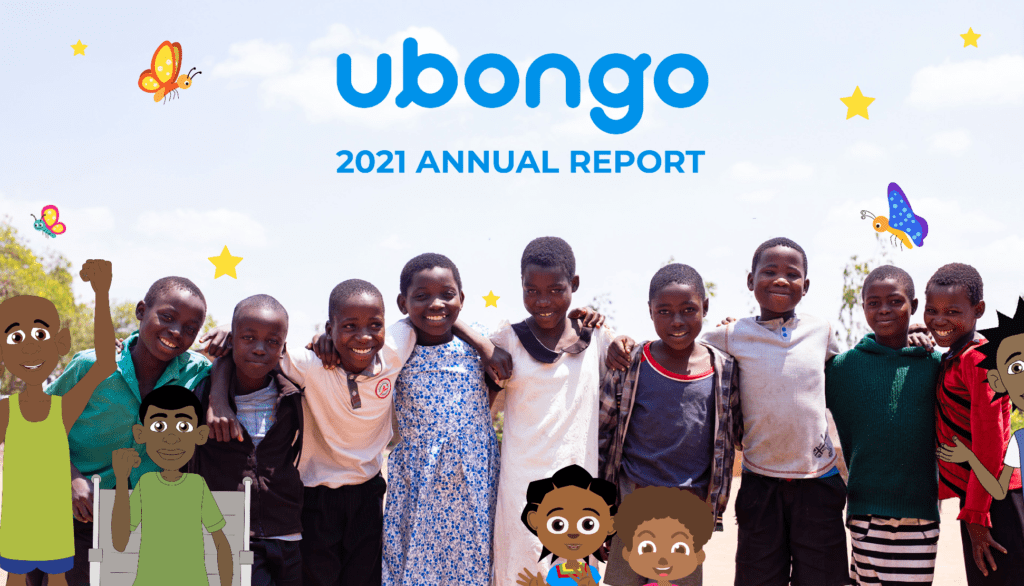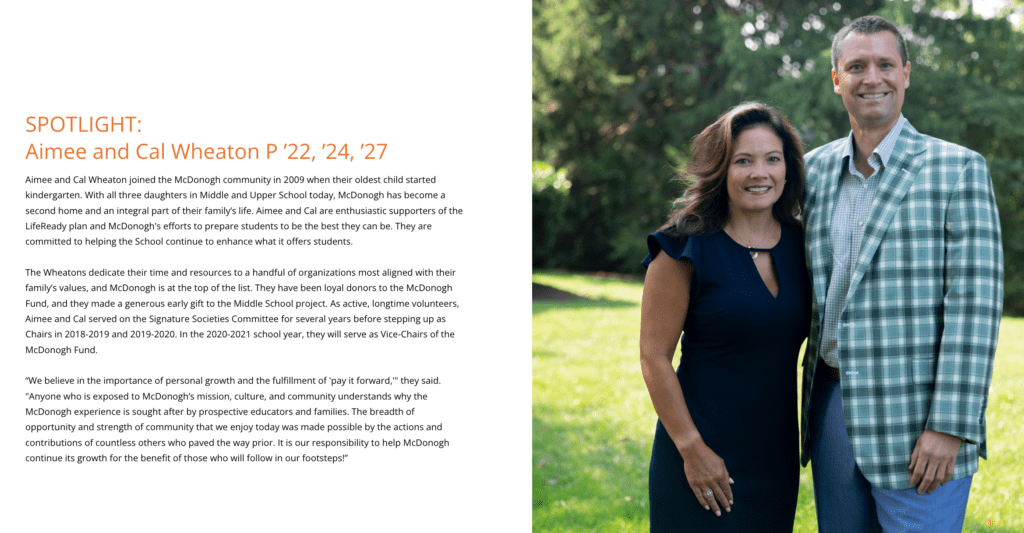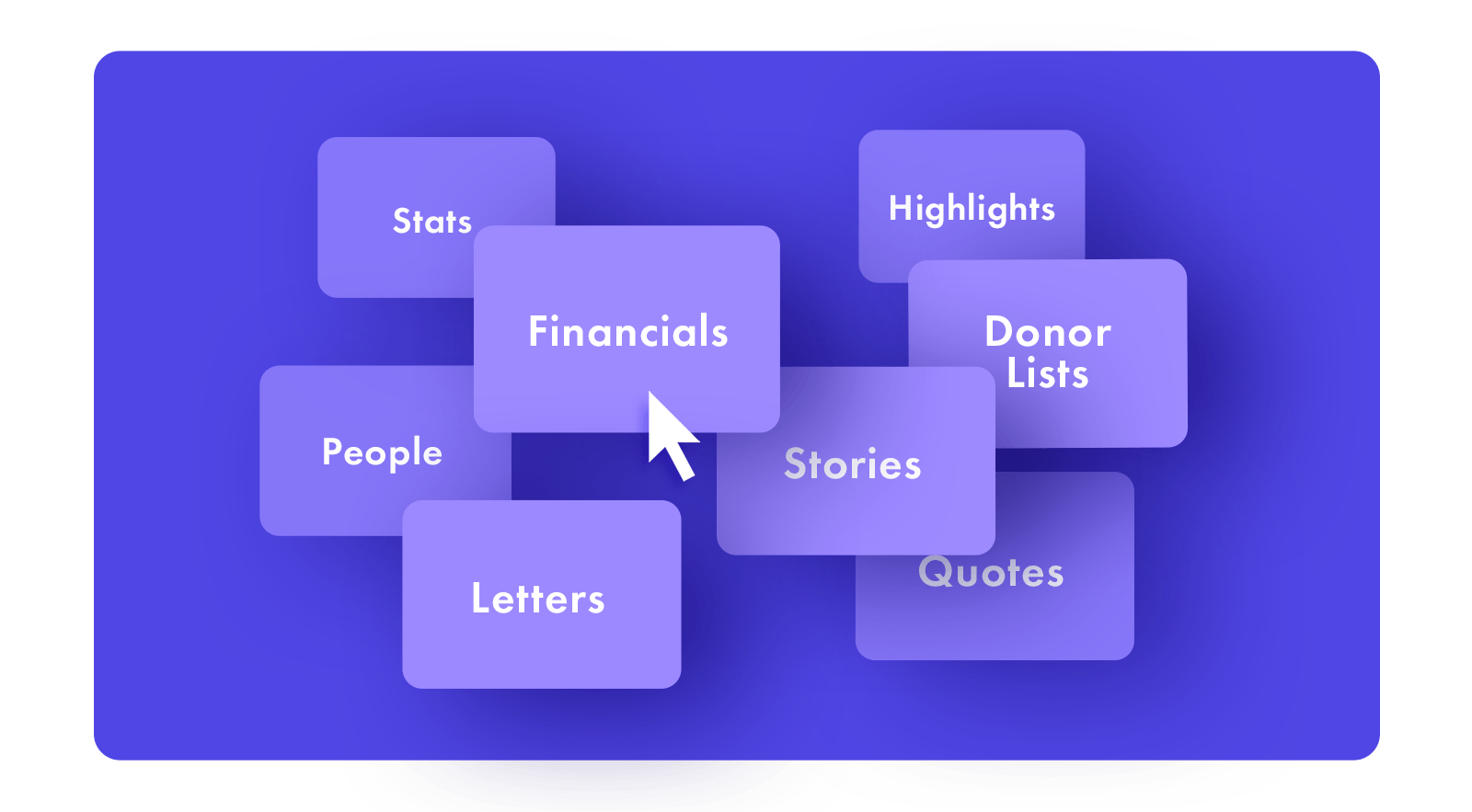
Education-related or school annual reports are great opportunities to connect with your community. In this blog, we’ll walk through what you should include in your school’s report. And, how to design one yourself, including:
An annual report for a school is just like an annual report for any other nonprofit organization. Great annual reports showcase a year’s worth of impact, accomplishments, and updates to help engage their community. Unlike Form 990, an annual report is optional, but an industry standard.
Usually, the development team at the school creates and writes the annual report. They oversee the content that is included within the report itself. The marketing team, if there is one, also plays a big role, too. From editing the content to disseminating it, the marketing team makes sure it finds the right people, at the right time.
Typically, schools publish their annual reports in the fall. At this point, the fiscal year is over, and the development team has had a chance to organize its accounting. Publishing in the fall is also great for motivating donors to give. The holiday season and Giving Tuesday are not only great times to showcase impact. They’re also great times to ask for donations.
A school annual report is a great opportunity to connect with the community. Many schools create their reports to update supporters on new events, community outreach, and even offer some spotlights on student achievements.
Regardless, annual reports act as an engagement tool. They educate, inspire, and excite communities to stay connected and supportive of the mission.
⭐ Ready to start using an annual report builder? Sign up for Yearly →
No two school annual reports will look the same. But, most include the following sections:
Once you’ve nailed all the right sections, it’s time to get creative.
Once you’ve obtained all the right information and enlisted the best stakeholders to help, its time to understand how to write the annual report . Text-heavy paper reports are a thing of the past. Instead, supporters are more interested in reading scannable content and hearing emotional stories. And, interacting with the content itself.
To do this we recommend:
Selecting a school annual report template: By using an annual report builder, schools can select from a variety of templates to start their annual report. Depending on the theme of the annual report, brand colors, or fonts, some templates might be better suited for their report than others.
Embed videos from past events, panels, and workshops: It’s great to include written information about these past events. But, it’s even more important to embed the video right into the report. That way, supporters can watch the recap in real-time.
Include graphs and charts: When showcasing your accomplishments and detailing your financial information, use data visualization . The more understandable you can make dense material, the better.
Add custom donation links: Readers want a seamless experience. That means including custom donate links . In doing so, so supporters can contribute right from your report.
Integrate social media: Have a post from the past year that reflects your mission? Embed the post right into the report! This shows readers that you’re dedicated to staying relevant. And, it allows them to follow your work on another platform.
Use drag-and-drop editing. By using digital report builders, organizations can use drag-and-drop editing to save time and energy when resting their reports. Insert text boxes, images, and more, by selecting pre-made design elements.
Invite collaborators. Writing an annual report takes lots of effort and energy. By using software that allows for multiple collaborators—at the same time—organizations can make their annual report design a group effort.
Now that we’ve covered how to write an annual report , let’s check out how to share it.
One of the best things about making your impact and annual report digital ? You can share it almost anywhere.
On social media: Post your annual report to LinkedIn, Twitter, or even Facebook. Tag alumni and important stakeholders so they don’t miss it.
In an e-newsletter: Embed your annual report right into an e-newsletter. Send it out to important alumni, donors, and staff.
At a conference : Big academic conference coming up? Project your annual report as a presentation or slide deck.
Within your school’s website: Create a tab on your website that includes all your annual reports. This way, supporters can view them at any time.
Send it out via snail mail: Digital annual report software gives organizations the ability to download their report into a printable pdf. That means organizations can print and send out their report via snail mail—the old-fashioned way.
Now that we’ve covered all the basics of writing a school annual report, it’s time to take a look at some of the best annual report examples, in order to get a bit more inspiration.

This digital report does a great job of building an emotional connection with readers, and telling their unique organizational story at the same time.
Why we love this digital annual report:

Harvard University takes its annual report to a whole new level of interactivity.
Why we love this digital report:

Ubongo’s school annual report is full of branded elements making it show-stopping marketing tool.
Why we love this digital report:

The McDonogh school annual report is a great example of data visualization in action and expert supporter engagement.
Why we love this digital report:

Regardless of your school’s mission, a digital report is a great way to excite readers, show gratitude, and turn readers into lifelong donors.
With templates, drag-and-drop editors, and a mobile responsive platform, anyone in your organization can create award-winning reports that help you make more impact than ever before. Plus, a digital annual report allows schools to share their findings in a variety of ways, start reaching brand-new followers, and keep in touch with old ones.
Ready to get started on your school annual report for free? Check out Yearly’s free 14-day trial.
Josh Kligman is the CEO of Yearly, a platform for nonprofits to create their own digital reports. Josh has been working with nonprofits on annual reports, brand and partnerships since 2011. He is helping nonprofits create more engaging, digital annual and impact reports with Yearly. Throughout his career, Josh has helped launch and run nonprofit brand campaigns and media partnerships nationally and locally, using television, radio and web, to amplify the reach of campaigns and provide demonstrated value for non-profit stakeholders. Josh received his B.A. from American University in Communications and his M.B.A. from American University in Marketing Management and Entrepreneurship.
With custom templates and drag-and-drop features, K-12 schools are able to quite literally show their impact. Each of these schools takes a different approach to beautifying and simplifying the report.
As head of sales, Sabrina Biggers is connecting with new customers, contributing to a 700% growth in revenue since joining Storyraise in June. And this uptick is unlocking new successes.
Make your report inclusive for readers with visual or auditory impairments or color blindness by incorporating these suggestions, gathered from the Americans with Disabilities Act.